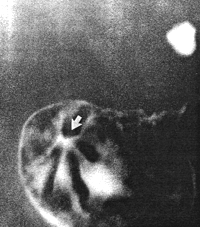


Go to chapter: 1 | 2 | 3 | 4 | 5 | 6 | 7 | 8 | 9 | 10 | 11 | 12 | 13 | 14 | 15 | 16 | 17 | 18 | 19 | 20 | 21 | 22 | 23 | 24 | 25 | 26 | 27 | 28 | 29 | 30 | 31 | 32 | 33 | 34 | 35 | 36 | 37 | 38 | 39
Chapter 13 (page 64)




Go to chapter: 1 | 2 | 3 | 4 | 5 | 6 | 7 | 8 | 9 | 10 | 11 | 12 | 13 | 14 | 15 | 16 | 17 | 18 | 19 | 20 | 21 | 22 | 23 | 24 | 25 | 26 | 27 | 28 | 29 | 30 | 31 | 32 | 33 | 34 | 35 | 36 | 37 | 38 | 39
Chapter 13 (page 64)
 |
Fig. 13.19. Double contrast. Pyloric mucosal folds converge on aperture (arrow), causing mucosal closure |
On the duodenal side, under these circumstances, a similar convergence of mucosal folds
toward the pyloric aperture is evident.
On radiological evidence it is concluded that, at times when the pyloric sphincteric
cylinder is filled but inactive, the aperture may be plugged by both gastric and duodenal
mucosal folds converging on it, or it may be closed in a shutter-like way by oblique
mucosal folds on the gastric side.
In a series of fresh partial gastrectomy specimens (removed because of gastric or
duodenal ulceration), Williams (l962) demonstrated mucosal closure of the pylorus.
These specimens, consisting of the distal half of the stomach and the first one or two
centimeters of the duodenum, retained their pliability for some hours after operation.
When barium was poured into such a gastric "bag" it did not always run out of the
pylorus. In 8 of 40 specimens, the pylorus was watertight to a pressure of 4.0 to 10.0 cm
of barium suspension with a specific gravity of 1.2. Williams (l962) called it a
watertight, physiologically closed pylorus; viewed from the duodenal side, bulging,
pliable gastric mucosal folds were seen to occlude the aperture. A probe 5.0 mm in
diameter could be passed into the stomach, withdrawn and the pylorus remained
watertight. When the probe reached a diameter of 10.0 mm it met the resistance of the
muscular ring. Transverse anatomical sections of fresh specimens also showed the
muscular ring to have a diameter of 10.0 mm, the opening being occluded by mucosal
folds. In one of the cases nylon threads were tied to the mucosa on the gastric side of the
pylorus. Pulling towards the fornix pulled the mucosal "plug" out of the ring into the
stomach, causing the barium suspension to run out, i.e. the pylorus opened. When
tension on the threads was released the mucosa returned, closing the pylorus.
It is concluded that radiological observations as well as experimental anatomical
investigations show that the pyloric aperture may be closed by mucosal "plugging" or
mucosal occlusion. This is seen during stages when the adjacent part of the stomach, i.e.
the pyloric sphincteric cylinder, is filled but inactive. (A small collection of barium
situated centrally at the base of the bulb may sometimes fill the hollow of the closed
pyloric aperture; this we have called the duodenal "tail". In cases of pyloric carcinoma it
may appear to be uninvolved, as described in Chapter 33).
Previous Page | Table of Contents | Next Page
© Copyright PLiG 1998